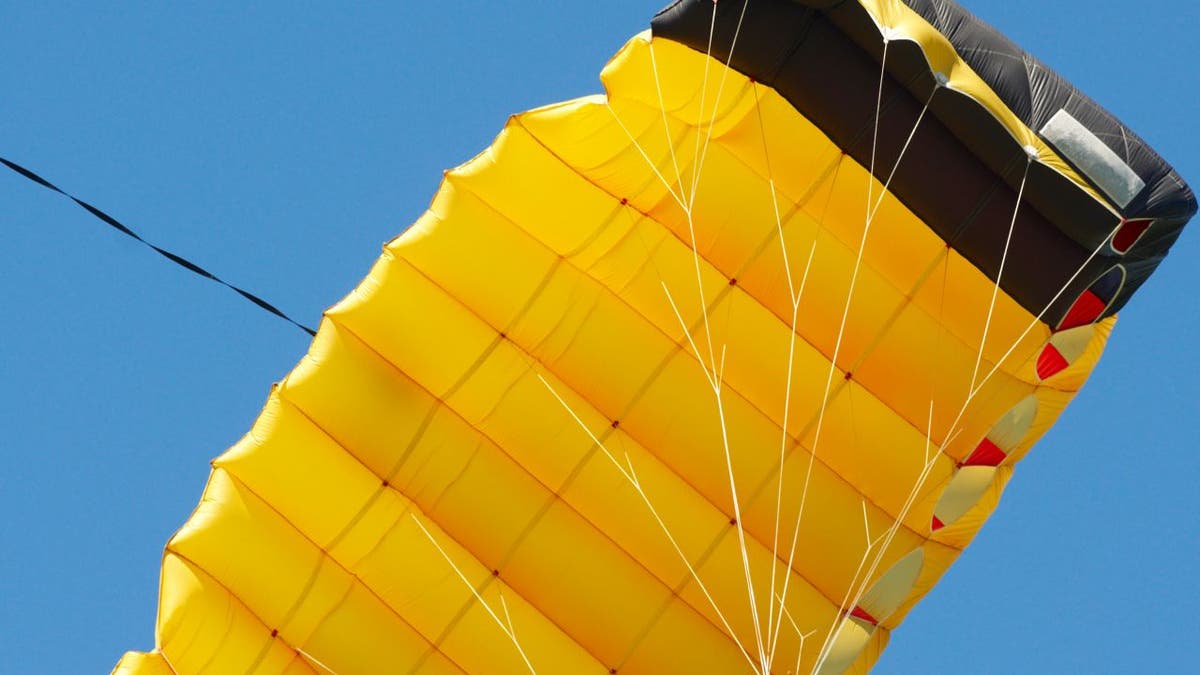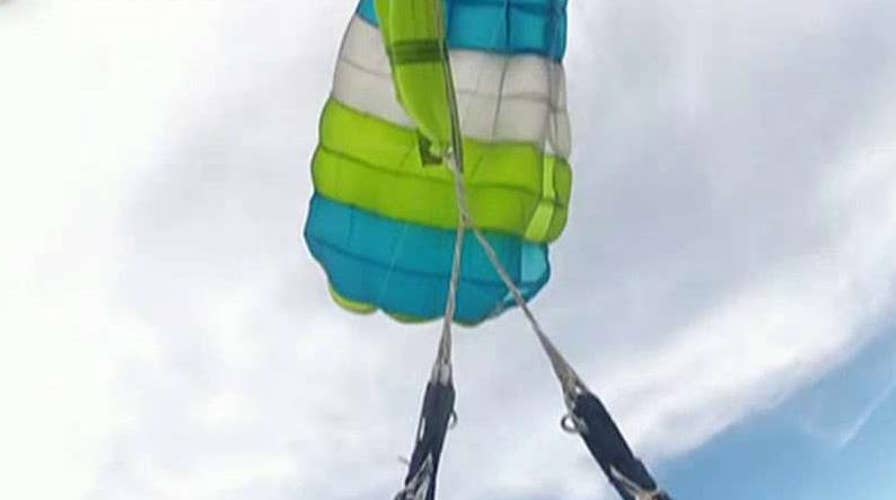GoPro captures terrifying moment skydiver loses parachute
Daniel Herndon opens up on his harrowing experience on 'Happening Now'
A skydiving instructor and tandem student were in an accident that led to the instructor’s death and the student suffering serious injuries.
The incident occurred in Waller County, Texas, where the skydiving instructor had been guiding their student through a tandem skydive lesson on behalf of Skydive Houston – a drop zone that offers skydive services from up to 13,500 feet. In a tandem lesson, the student shares a parachute with an instructor.
Skydive Houston issued a news release on Sunday confirming the incident occurred on Saturday, Feb. 19, at around 12:30 p.m. CST.
PARACHUTER GETS CAUGHT IN POWER LINES, LEFT DANGLING 30-FEET IN THE AIR FOR OVER AN HOUR
"[The tandem instructor and tandem student] were air-lifted to an area trauma center where the tandem instructor later succumbed to his injuries," Skydive Houston wrote in the issued statement. "The female tandem student is reported to be suffering from serious, but non-life-threatening injuries at this time."
The Texas-based skydive company wrote that "Skydive Houston has an excellent safety record, and significant injuries associated with tandem skydiving are extremely rare" while citing a skydiving safety statistics webpage put together by the United States Parachute Association (USPA).
Skydiving statistics: Fatality rates and more
The USPA reports that the skydiving fatality rate is 0.39 fatalities per 100,000 jumps. The organization came up with this calculation based on the records it has on file from 2020, which states approximately 2.8 million skydiving jumps were completed at more than 200 USPA-affiliated skydive centers.
Skydiving fatality rates have mostly trended downward in the last two decades, according to data published by the USPA. In 2000, the skydiving fatality rate was 1.19 fatalities per 100,000 jumps.
UTAH VETERAN, A PURPLE HEART RECIPIENT, FULFILLS SKYDIVING DREAM ON 90TH BIRTHDAY
While the USPA’s skydiving safety data webpage does not differentiate between tandem, solo or group formation jumps, the organization does note that tandem skydiving has a higher safety rate.
"Tandem skydiving—where you’re attached to an experienced skydiving instructor for your jump—has an even better safety rate, with one student fatality per 500,000 jumps on average over the past 10 years," the USPA wrote.
Other safety facts and figures the USPA wants aspiring skydivers to be aware of include skydive jump parachute systems having main and reserve systems, student parachutes having automatic activation devices that release the reserve parachute if the main one doesn’t deploy, annual equipment malfunction trainings for USPA-certified skydiving instructors, pre-flight inspections of skydive planes and emergency response trainings skydive jump pilots for accident prevention.
"The reality is that the vast majority of skydiving accidents are a result of simple human error," the USPA’s skydive safety stats page states. "Many of the accidents occur because the jumper—oftentimes an experienced skydiver who is pushing the limits— makes an error in judgment while landing a perfectly functioning parachute."
BEST SKYDIVING PLACES AROUND THE WORLD
Skydiving safety considerations
Skydiving is regulated by the Federal Aviation Administration. Though, a sport parachuting advisory circular from the federal agency recommends that first-time skydivers "seek instruction from instructors that have met the qualifications set forth by the USPA or other similar skydiving associations."
The USPA has a list of certified Group Members and foreign affiliate drop zones on its website, which includes skydiving schools, clubs and centers that reportedly meet the organization’s safety standards.
Aspiring skydivers can search for USPA Group Members by name, city, state, region and country through the USPA Group Member And Foreign Affiliate Drop Zone Locator.
![Skydiving is regulated by the Federal Aviation Administration. Though, an FAA sport parachuting advisory circular recommends first-time skydivers 'seek instruction from instructors that have met the qualifications set forth by the [United States Parachute Association] or other similar skydiving associations.'](https://a57.foxnews.com/static.foxnews.com/foxnews.com/content/uploads/2021/06/1200/675/iStock-470796871.jpg?ve=1&tl=1)
Skydiving is regulated by the Federal Aviation Administration. Though, an FAA sport parachuting advisory circular recommends first-time skydivers 'seek instruction from instructors that have met the qualifications set forth by the [United States Parachute Association] or other similar skydiving associations.' (iStock)
The USPA notes that there is "no official organization [that] rates the safety of skydiving centers."
FLORIDA MAN DESCRIBES TERRIFYING HANG GLIDER MISHAP OVER SWITZERLAND, HANGING ON FOR DEAR LIFE
However, the organization does encourage skydivers to ask drop zone providers about their safety records when making a decision to go skydiving.
Are you signing your life away?
The USPA acknowledges that skydiving is a sport that has "potential risks involved."
It’s standard practice for skydiving schools and drop zones to provide jumpers registration forms and liability releases that need to be signed before a jump can be completed, according to an FAQ page on the USPA’s website.
Most if not all legitimate skydiving institutes note that there’s a possibility of injury or death in their liability waivers.
CLICK HERE TO GET THE FOX NEWS APP
In Skydive Houston’s liability waiver, which is accessible online at the time of writing, says, "Parachute systems sometimes fail to operate correctly, even when properly manufactured, assembled, packed, and operated. You risk serious injury or even death each time you use this system."
The waiver goes on to warn that tandem jumpers who sign the liability document agree to not sue.
"This legal document is a contract between us which states that we will do everything in our power to make it as safe as possible; however, you are jumping out of an airplane and anything could happen," Skydive Houston’s liability waiver states, as of Monday, Feb. 21. "So, by signing this document, you are stating that you and your family are assuming the risk of serious injury and/or death and agree never to sue Skydive Houston or any other parties involved."
FOLLOW US ON FACEBOOK FOR MORE FOX LIFESTYLE NEWS

The United States Parachute Association acknowledges that skydiving is a sport that has 'potential risks involved.' The organization says it's standard practice for skydiving schools and drop zones to provide jumpers registration forms and liability releases that need to be signed before a jump can be completed. (iStock)
Marketing materials on Skydive Houston’s website report that the company hires tandem instructors who have a certification from the USPA. The company also says its team of instructors have completed more than 50,000 skydive jumps combined.
Jump operations are currently suspended at Skydive Houston as local law enforcement and the Federal Aviation Administration investigate the incident.
CLICK HERE TO SIGN UP FOR OUR LIFESTYLE NEWSLETTER
"Skydive Houston, along with the greater skydiving community at large, is deeply saddened by the loss of our tandem instructor and friend," Skydive Houston wrote in its release. "Our sincerest condolences are extended to his friends and family. We continue to pray for a full recovery for the injured tandem student."
Fox News Digital reached out to Skydive Houston and the USPA for comment.




















